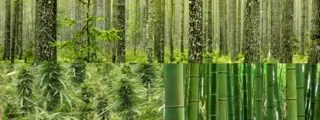
If you’ve heard the buzz about making paper from hemp or bamboo plants, you have to wonder whether it measures up to paper in terms of widespread availability, sustainability and performance?
In a word, no.

This chart says it all. All three resources—trees, bamboo and hemp—are natural and renewable, but that’s where the similarities end. Bamboo and hemp cannot be planted and grown in North America at a scale that would allow for broad or consistent access without high environmental risks, according to research by the nonprofit Two Sides North America. Wood fiber is part of a well-developed infrastructure capable of meeting market demand with the lightest footprint possible.

Paper’s story is even better! Paper products made from wood fiber are frequently recycled, which keeps them out of landfills and turns them into new products—up to seven times.
Finally, forests are usually a better use of land than a non-wood fiber crop in terms of:
- The variety of habitats they provide to birds and animals
- Water and soil protection. Tree roots absorb water and can hold soil in place, preventing erosion from runoff. They also act as natural water filters.
- Carbon storage. Because they grow rapidly, young trees absorb carbon dioxide—a gas linked to climate change—more quickly than older ones. Older forests, meanwhile, have larger trees that contain more carbon dioxide because of their size and age. When either young or old trees are used to make paper, the stored carbon remains in the products, according to the U.S. Department of Agriculture.

Growing hemp and bamboo can come with unintended consequences, according to the World Wildlife Fund. It warns that
poor selection of sites for fiber plantations or faulty management might require excess water use if there’s insufficient rainfall or lead to more pollution from chemicals or fertilizers if the fiber plant isn’t ideally suited to the area.
Additionally, in areas where fiber plantations have replaced natural forests, valuable carbon sinks have been lost. If new trees aren’t planted, then a region’s total carbon dioxide emissions may increase, since a mature live tree can absorb more than 48 pounds of carbon dioxide a year, according to the U.S. Forest Service.
For some niche products, it may make sense to use plant-based fibers. Hemp, for example, is a good fit for certain specialty papers, like filter papers and tea bags. Wood fiber, however, is a better fit for others, like most common printing papers.
The bottom line is that paper and packaging companies have developed their pulp sourcing practices over many decades, carefully balancing attributes such as affordability, availability and sustainability. Ultimately, what the industry wants is to make the best, most affordable and most sustainable products that will meet customer expectations.
